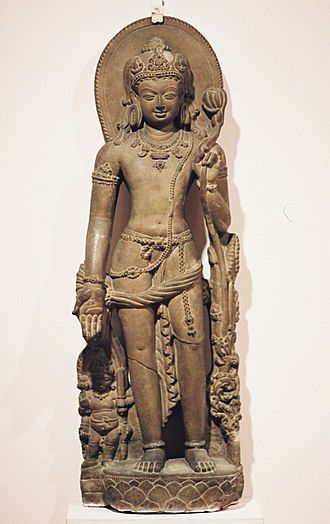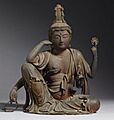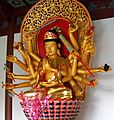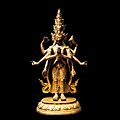Avalokiteśvara facts for kids
Quick facts for kids Avalokiteśvara |
|
|---|---|

|
|
| Sanskrit |
|
| Burmese | ကွမ်ယင် IPA: [kwàɴ jɪ̀ɴ] |
| Chinese |
|
| Japanese |
|
| Khmer |
|
| Korean |
|
| Thai |
|
| Tibetan | སྤྱན་རས་གཟིགས THL: Chenrézik |
| Vietnamese |
|
| Information | |
| Venerated by | Mahayana Vajrayana Theravada Chinese folk religion Taoism |
| Attributes | Compassion |
In Buddhism, Avalokiteśvara is a very important bodhisattva. A bodhisattva is someone who has reached enlightenment but chooses to stay in the world to help others. Avalokiteśvara is known for his incredible compassion for all living things. He is often seen as a helper to Amitabha Buddha.
Avalokiteśvara can appear in many forms, sometimes as male and sometimes as female. One of his most famous female forms is Guanyin in East Asia.
Contents
What Does the Name Mean?
The name Avalokiteśvara comes from ancient Sanskrit words. It means "the lord who gazes down" at the world. This shows his role in watching over and helping everyone.
An older form of the name was Avalokitasvara, which means "the one who looks down upon sound." This refers to him hearing the cries of people who need help. The Chinese name Guanyin also means "Perceiving sound" or "hearing the world's cries."
In Tibet, Avalokiteśvara is called Chenrézik. This name means "the one who always looks upon all beings with the eye of compassion."
Where Did Avalokiteśvara Come From?
Mahayana Buddhist Stories
The name Avalokiteśvara first appeared in an important Buddhist book called the Avatamsaka Sutra. He also features in the Lotus Sutra, especially in Chapter 25. This chapter describes him as a kind bodhisattva who listens to the troubles of all living beings. He works hard to help anyone who calls his name.
The Lotus Sutra says Avalokiteśvara can appear in 33 different forms. These forms help him connect with all kinds of people. This chapter is so important that it is often read or chanted on its own in East Asian Buddhist temples.
Ancient travelers like Faxian (around 400 CE) and Xuanzang (in the 7th century) wrote about seeing statues of Avalokiteśvara. People from all walks of life, from kings to ordinary people, showed him great respect.
In Chinese Buddhism, a special form of Avalokiteśvara called Cundī is very popular. She is often shown with many arms.
Theravada Buddhist Beliefs
Avalokiteśvara is also honored in countries where Theravada Buddhism is common, like Sri Lanka and Myanmar. In Sri Lanka, he is known as Natha-deva. In Myanmar, he is called Lokanat. He is usually found in shrine rooms near Buddha images.
Even though Theravada Buddhism mainly follows the Pali Canon, Avalokiteśvara is a Mahayana figure who has become part of their worship. This shows how widely respected he is.
Important Mantras
A mantra is a sacred sound or phrase repeated during meditation or prayer. Avalokiteśvara is strongly connected to the six-syllable mantra: oṃ maṇi padme hūṃ.
In Tibetan Buddhism, this mantra is very important. People often repeat it while using Buddhist prayer beads. They also spin prayer wheels that have this mantra written on them many times. Spinning the wheels is believed to spread good energy and help everyone nearby.
This famous mantra first appeared in a text called the Kāraṇḍavyūhasūtra around the 4th or 5th century CE. Another mantra for Avalokiteśvara in East Asia is Om Arolik Svaha.
The Thousand-Armed Avalokiteśvara
There's a famous story about why Avalokiteśvara has a thousand arms. He made a promise never to rest until he had freed all living beings from suffering. But no matter how hard he tried, he saw that many beings were still unhappy.
Trying to understand the needs of so many people, his head split into eleven pieces. Amitābha Buddha, seeing his struggle, gave him eleven heads. This allowed him to hear the cries of even more suffering beings.
Then, Avalokiteśvara tried to reach out to everyone who needed help, but his two arms shattered. Again, Amitābha Buddha came to his aid. He gave Avalokiteśvara a thousand arms. With these many arms, he could reach out and help countless people who were suffering.
You can see a wonderful wooden image of the Thousand-Armed Avalokiteśvara at the Bao'en Temple in Sichuan, China.
Different Forms of Avalokiteśvara
Avalokiteśvara appears in many different forms. Each form has a special meaning or helps in a specific way. Here are some of the commonly known forms:
| Sanskrit Name | Meaning | What it Represents |
|---|---|---|
| Āryāvalokiteśvara | Sacred Avalokitesvara | The main or original form of the Bodhisattva |
| Ekādaśamukha | Eleven Faced | Has extra faces to teach beings in all ten levels of existence |
| Sahasrabhuja Sahasranetra | Thousand-Armed, Thousand-Eyed Avalokitesvara | A very popular form that sees and helps everyone |
| Cintāmaṇicakra | Wish Fulfilling Avalokitesvara | Holds a special jewel that grants wishes and a wheel |
| Hayagrīva | Horse-necked one | A powerful, fierce form that also helps beings |
| Cundī | Extreme purity | Often shown with many arms |
| Amoghapāśa | Unfailing noose | Avalokiteśvara holding a rope and net to save beings |
Images for kids
-
Avalokiteśvara painting from a Sanskrit palm-leaf manuscript. India, 12th century.
-
Avalokiteśvara / Padmapani, Ajanta Caves, India
-
Bronze statue of Avalokiteśvara from Sri Lanka, ca. 750 CE
-
Pothigai Malai in Tamil Nadu, proposed as the original Mount Potalaka in India
-
Shrine to the Thousand-Hand Guanyin (Qianshou Guanyin) and Eleven-Headed Guanyin (Shiyimian Guanyin) on Mount Putuo Guanyin Dharma Realm in Zhejiang, China
-
Magnificent clay images of Amoghpasha Lokesvara flanked by Arya Tara and Bhrikuti Tara enshrined at the side wing of Vasuccha Shil Mahavihar, Guita Bahi, Patan : This set of images is popular in traditional monasteries of Kathmandu Valley, Nepal.
-
Indian cave wall painting of Avalokiteśvara. Ajaṇṭā Caves, 6th century CE.
-
Cambodian statue of Avalokiteśvara. Sandstone, 7th century CE.
-
Padmapani holding a lotus. 8th-9th century Sailendran art, Plaosan temple, Java, Indonesia.
-
Eight-armed Avalokiteśvara, ca. 12th-13th century (Bàyon). The Walters Art Museum.
-
Avalokiteśvara from Bingin Jungut, Musi Rawas, South Sumatra. Srivijayan art (c. 8th-9th century CE)
-
The Privy Seal of King Ananda Mahidol of Thailand show a picture of a Bodhisattva, based on a Srivijayan sculpture of Avalokiteśvara Padmapani which was found at Chaiya District, Surat Thani Province.
-
Malaysian statue of Avalokiteśvara. Bidor, 8th-9th century CE.
-
Chinese statue of Avalokiteśvara looking out over the sea, c. 1025 CE.
-
Chinese hanging scroll depicting Shancai, Avalokiteśvara and Longnü, Yuan Dynasty.
-
Standing Kannon Bosatsu (Avalokitesvara), 12th century, Heian period, Tokyo National Museum, Japan.
-
Senju Kannon by Tankei, 13th century, Sanjūsangen-dō, Japan.
-
Nepalese statue of Avalokiteśvara with six arms. 14th century CE.
-
Avalokiteśvara of One Thousand Arms, lacquered and gilded wood. Restored in 1656 CE. Bút Tháp Temple, Bắc Ninh Province, Vietnam
-
Tibetan statue of Avalokiteśvara with eleven faces.
-
Tang dynasty (896 AD) carved stone statue of Qianshou Guanyin in Shengshui Temple (內江聖水寺) in Neijiang, Sichuan, China
-
Esoteric Cundī form of Avalokiteśvara with eighteen arms in Lingyin Temple in Hangzhou, Zhejiang Province, China.
-
Thousand-armed Avalokiteśvara bronze statue from Tibet, circa 1750. Birmingham Museum of Art
-
Mongolian statue of Avalokiteśvara (Migjid Janraisig). Tallest indoor statue in the world, 26.5-meter-high, 1996 rebuilt, (1913)
-
The wooden statue of thousand-armed and thousand-eyed Guanyin at the City of Ten Thousand Buddhas in Ukiah, California.
See Also
 In Spanish: Avalokiteshvara para niños
In Spanish: Avalokiteshvara para niños
- Guanyin
- Ishvara
- Pure Land Buddhism
- Ushnishasitatapattra
- Vishnu
- Dalai Lama












































